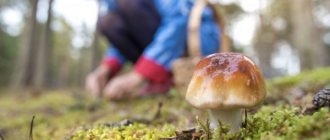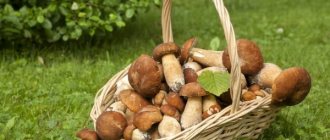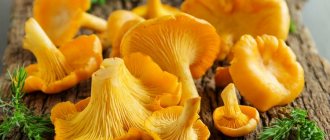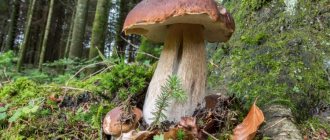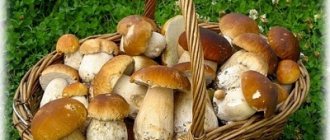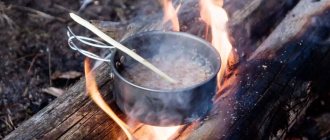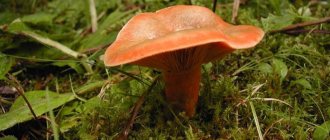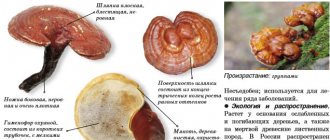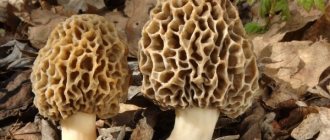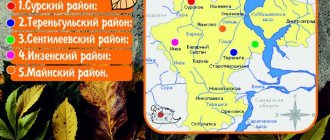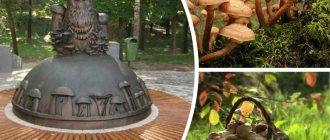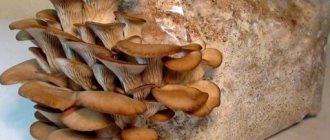Mushrooms
2
1664
Article rating
Kira Stoletova
More than 3,000 species of mushrooms are found in Russia. Obviously, they do not grow up overnight. Therefore, it is important to know when the long-awaited mushroom season begins in order to start collecting certain species on time. Let's try to understand the intricacies of gathering in spring, summer and autumn, as well as other fundamentally important aspects of quiet hunting.
When does mushroom season start?
Fruitful mushroom places
There is no clear answer to the question of where mushrooms are now collected. Avid hunters always keep such information secret and share it only with very close friends and relatives.
Experts say that today there are few places left where you can pick mushrooms. Mostly these should be environmentally friendly and safe areas. But the industrial zones located in the territories, the smoking plants and factories located nearby, greatly interfere with the growth of edible, safe mushrooms.
It is important to remember that even an edible mushroom, but grown in an environmentally unsafe area, can be poisonous.
The fact is that mushrooms, like sponges, absorb chemicals released into the air by enterprises, as well as moisture saturated with wastewater.
- In Russia, places on the map where it is categorically dangerous to collect and consume wild mushrooms have long been marked in red.
- And most importantly, it is worth remembering that quiet hunting is relevant only in areas remote from dusty roads and highways.
Where to pick mushrooms in the forest? Where there is a swamp or lake nearby. Mushrooms love moisture very much. After all, everyone notices how quickly they grow after rain. Suitable for collection are mixed coniferous-deciduous forests and plantings, areas where there are fallen trees, and edges.
Fruiting time
Despite the large number of families growing in the Moscow region, the number of noble species borders on less popular and poisonous mushrooms. To collect at least one basket of healthy product and not get poisoned, you should know three important criteria:
1) distinctive features of edible mushrooms from false and poisonous ones;
2) time of collection (not all species germinate during the peak season);
3) a place known for its rich harvest (can be found on the map and reviews left over the last one or two years).
Mushroom picking routes in the Moscow region
You can have a successful hunt if you know where to go for mushrooms. Their different species grow in certain areas of the Moscow region. In the south you can collect boletus, boletus, and porcini mushrooms.
In the north - russula, chanterelles, champignons. Honey mushrooms and bluelegs grow in the west. The East is famous for chanterelles, boletuses, and boletus.
Mushroom King
This is what experts call the porcini mushroom. This is a rare representative of this family, but you can find it in the Moscow region. When and where to collect porcini mushroom? The most interesting thing is that myceliums of this species persist in the same places for decades.
Therefore, experienced hunters always remember these territories and use their knowledge every year.
- The porcini mushroom grows in mixed or coniferous forests, as well as deciduous groves.
- There are several types of this mushroom: birch mushroom, boletus mushroom, oak mushroom, spruce mushroom. The names speak for themselves.
- A whole basket of such mushrooms can be collected on the sandy soils of birch forests.
Chanterelles
No less common variety. Where do chanterelles collect mushrooms? In mixed forests from June to October. They lurk in the grass or rotted leaves. Like chanterelles, honey mushrooms and boletus also love moist, humus-rich soil.
boletus
Birch forests are not uncommon in the Moscow region. If you go to their open spaces, you can find boletus mushrooms. The varieties of these mushrooms differ in the colors of their caps. Some of them are almost white, matching the bark of the tree of the same name. Others are light beige or dark brown. They grow on thin, tall legs with whitish-gray scales.
- The boletus has an unpleasant counterpart - the gall fungus. Insects and worms never eat it; it is bitter.
- These differences are basic. If it is not worth tasting the raw mushroom, it is advisable to pay the main attention to the presence of worm holes on the caps.
- The gall fungus is not poisonous, so it will not cause poisoning, experts say. However, a false boletus that gets into a dish with its double will completely ruin the taste.
Bluelegs
Mushrooms popular in the Moscow region. They can be found near abandoned agricultural enterprises, mainly in open spaces. Bluish legs and yellowish caps are characteristic of this species.
Some bluelegs have a lilac-colored base. Bluelegs looks a little like russula. Plantations of these mushrooms appear closer to November. This type of mushroom is not afraid of slight frosts and grows well even in the middle of the last autumn month.
In most regions, including the Moscow region, bluelegs is classified as a weed mushroom, although it is not poisonous. But Europeans are accustomed to considering it a delicacy. The Japanese value it even more than truffles.
Recommendations
- Linkoff, Gary. (2010). The Complete Mushroom Hunter: An Illustrated Guide to Finding, Harvesting, and Using Wild Mushrooms
. Beverly, MA: Quarry Books. pp. 7–11. ISBN 978-1-59253-615-3. OCLC 437298961. - Ho, Marco H. C.; Hill, David J. (2006). "Food hypersensitivity to white champignon in a child." Journal of Pediatrics and Child Health
.
42
(9):555–556. Doi:10.1111/j.1440-1754.2006.00922.x. PMID 16925545. - "LBM" www.mushroomthejournal.com
. Retrieved December 16, 2022. - Gange, A.C.; Gange, E. G.; Sparks, T. H.; Boddy, L. (2007). "Rapid and recent changes in fungal fruiting patterns." The science
.
317
(5821): 71. Bibcode:2007 Science ... 316 ... 71G. Doi:10.1126/science.1137489. PMID 17412949. S2CID 11405866. - "Morel National Mushroom Festival - Official site of the mushroom festival held every May in Boyne City, Michigan." www.morelfest.com
. Retrieved December 16, 2022. - "Texas Mushroom Festival" www.texasmushroomfestival.com
. Retrieved December 16, 2022. - "Telluride Mushroom Festival - Mushroom Hunt - Mushroom Picker." Telluride Mushroom Festival
. Retrieved December 16, 2022. - Arora, David. Demystifying mushrooms. Ten Speed Press, 1986
- "Amanita muscaria, edible when steamed." September 30, 2011. Retrieved December 16, 2022.
- Michael W. Bueg, Marilyn Shaw, and Kenneth W. Cochran. Thirty-odd years of mushroom poisoning: a summary of approximately 2000 reports in the NAMA case registry. Archived 2010-12-21 on the Wayback Machine
- "Hans E. Gruen." Retrieved December 16, 2022.
- "Finding and Cooking the Elusive Matsutake Mushroom." Retrieved December 16, 2022.
- "Tricholoma magnivelare, American matsutake mushroom, Tom Wolf's Mushroom of the Month for September 2000." botit.botany.wisc.edu
. Retrieved December 16, 2022.
Where to find a lot of mushrooms
Central Russia is famous for its mushroom places. Good harvests can be harvested from abandoned pastures that have already begun to be overgrown with bushes and small trees. Mushrooms can also be found in mixed forests where the soil is fertile and moist. Coniferous groves located on sandstones are also a favorite place for the growth of mycelium. Well-lit areas on the edges are considered the most favorable for mycelium.
- Many mushroom pickers go on a quiet hunt by train.
- In this case, driving past a field overgrown with bushes, you can safely get off at the nearest stop.
- There is no need to go deep into the forest. Mushrooms appear more often on the outskirts and edges. Myceliums are always associated with plant roots.
- Therefore, you need to look for them where the roots of the trees emerge.
The mushroom route should be thought out in advance. Even in winter. But in early spring you need to walk it, checking for the presence of mycelium plantations.
Nosovikhinskoe and Gorkovskoe highways: be careful - peat bogs!
No, honestly: in these places (Pavlovo-Posad district) there was a lot of smoke just recently, just two or three weeks ago. Therefore, it is advisable to walk here carefully. Among the “generally recognized” mushroom places are the surroundings of the villages of Subbotino and Vlasovo. You can get to the first one by turning from Gorkovka to Pavlov Posad. Here, from Mira Street, turn onto 1st May Street, then, through the 1st and 2nd lanes of 1st May, exit onto Stepurinskaya Street, and follow it all the way to Subbotino.
You can get to Vlasovo along Nosovikhinskoye Highway, turning right towards Rakhmanovo. Continue along the highway to the U-shaped intersection. And there - either to the left, to Vlasovo, or to the right, to Semenovo - there are continuous forests all the way to Yegoryevskoye Highway.
The only thing is that it’s still far from Moscow...
What time is it easy to pick a basket of mushrooms?
It is useless for those who like to sleep longer to engage in quiet hunting.
- Mushrooms should be picked early in the morning.
- Some avid mushroom pickers arrive in forests and other quiet hunting areas in advance, around 4 am.
- But the most experienced mushroom pickers stay in the forest overnight, in a tent.
- Many people walk along the paths at night with a flashlight.
What is collected in the spring
The mushroom picker's calendar says that in the first weeks of spring, the previously mentioned strings (ordinary, giant or peaked) and morels (conical, tall, capped morels and other subspecies) appear in the forest.
These mushrooms can be consumed without fear, but only after proper heat treatment.
Also in the spring you can find the May or short-legged mushroom, double-ringed champignon (but it is found only in areas rich in organic matter), bighead, tinder fungus, spring honey fungus, petitsa and dung beetle.
Despite the peculiar names and knowledge about them (for example, about tinder fungus, which is known as a parasitic wood fungus), they are all widely used in Russian cuisine.
Important nuances
A number of rules should be followed before going on a quiet hunt and at the time of harvesting. It is worth choosing mushroom places located away from the busy sector.
Mushrooms never grow alone. Therefore, having found a couple, it is worth looking around and carefully combing the surroundings. Under no circumstances should you take a mushroom if you have doubts about its edibility. You should not cut off unfamiliar mushrooms either.
The collection should be carried out in comfortable closed clothes and shoes, and a hat, even if the morning turned out to be very warm.
Bohr highway
There is probably no point in trying to leave Moscow along the Borovskoye Highway - on your way you will encounter many traffic lights in Solntsevo (although, once you leave the city, you can drive several kilometers along a very good road). It’s probably better to continue along the same Kievskoye Highway to the repeatedly mentioned turn to Krekshino. And, at the first intersection, turn right onto a narrow two-lane road. Along it you will reach the village of Pobeda, the border of the town of Aprelevka. Leave your car here, cross the tracks of the Kyiv direction of the railway, and all the local mushrooms are yours.
Photos of the best varieties of mushrooms
Phytoncides
The forest itself has a beneficial effect on our body. Trees actively produce beneficial phytoncides. They are a protective reaction of trees to the external environment: bacteria, fungi, microorganisms, insects that try to harm the tree.
If you had a headache or a slight runny nose when entering the forest, then after several hours spent alone with nature, they may disappear without a trace. An important feature of phytoncides is to slow down or completely stop the development of microorganisms.
There are also a number of observations that phytoncides serve as an excellent prophylactic against frequent migraines, insomnia, and colds. Their presence in the air normalizes blood sugar and stimulates the functioning of the heart and brain. They enter our body through breathing and through the skin. The most phytoncides are in coniferous forests, however, they are also present in deciduous forests, but in smaller quantities.
Butter
MaslyataPhoto: commons.wikimedia.org
But even before the boletus mushrooms, in the twentieth of May, boletus mushrooms began to appear en masse near Moscow. You should look for these cute mushrooms (hence the name) exclusively in young pine trees, up to five meters high. I now find early boletus under trees, but most of them are in the tall grass in the field
The main thing here is not to choke the mushrooms and carefully move the thickets apart. But there must be pine trees nearby
What’s interesting: at the end of this spring, two types of butterweed began to appear simultaneously—grainy and real. Many mushroom pickers do not distinguish them, and this is not necessary - among the butter mushrooms there are no inedible species, and it is impossible to confuse them with some false poisonous double.
But if a grainy oiler is common at the beginning of summer, then a real one, denser and more powerful, appears only in August and September. The distinctive features of these two types are that the granular one does not have a film under the cap. Cold May played into the hands of Moscow mushroom pickers here too. Boletus, like boletus mushrooms, mistook the colder weather for autumn. I think there is no finer mushroom for pickling than buttercup. Some mushroom pickers remove the mucous skin from the cap, some boil it with it: it all depends on the individual reaction of the stomach and how aesthetically pleasing you want the mushroom in the jar to be. Without the skin, of course, it’s more beautiful.
| Recipe for pickled butter: For one liter of water: 2 tablespoons of sugar, 4 teaspoons of salt, 3 bay leaves, 6 black peppercorns, 3 cloves, 3 cinnamon sticks. Preparation. Add all ingredients to boiling water, remove from heat and add three teaspoons of vinegar essence. Cool. Pour the marinade over the boletus, previously boiled for five minutes with salt and vinegar. Cover (it is better not to roll up to avoid botulism) with a lid and store in a cool, dark place. |
